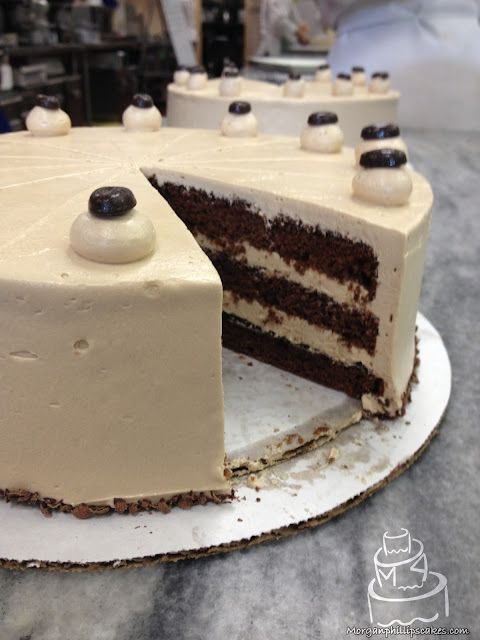Take the New Orleans' King Cake for example. Most people are familiar with the tradition of eating this cake around Mardi Gras and know that it looks something like this:
 |
| photo cred: foodnetwork.com |
The King's Cake is actually a tradition handed down from the French town of Pithiviers, where they would frequently serve an almond tart with a prize baked inside like a small chain necklace. Whoever was sliced the piece of cake containing the prize won the honor of being 'King' or 'Queen' for the day. It was two disks of puff pastry, decorated and stuffed with an almond filling called frangipane and it looked something more like this:
Or another dessert that was popular in America around the 1950's, but was originally created for a Russian princess, The Charlotte Russe. The classical version is vanilla sponge cake filled with Bavarian cream and chocolate shavings and encircled with ladyfingers (who have a story of their own) and tied up like a present with a red ribbon. Usually today, we spice Charlottes up quite a bit, if they are even served at all. In class I made a modern version that is circled with Jaconde (decorated) sponge cake instead of ladyfingers, and glazed with strawberry and passionfruit puree instead of chocolate shavings:
We made four different kinds of sponge cake, four different kinds of buttercream, and five different types of tarts. It wasn't quite as high production as my last bakeshop class, but we really focused on perfecting the techniques instead of churning things out. After the Pithivier and the Charlotte we got a lot more familiar:
Chocolate, caramel, and macadamia nut tart.
Traditional carrot cake with walnuts and cream cheese frosting.
Sliced and ready for service!
Traditional Black Forrest cake: chocolate sponge soaked in brandied cherry syrup, layered with cherry filling and fresh whipped cream. Garnished with chocolate curls.
Mocha cake: chocolate sponge filled with espresso buttercream and garnished with chocolate candies.
Hazelnut torte: hazelnut sponge filled with hazelnut buttercream and garnished with hazelnut Florentine.
It was a fantastic three week filled with cake, and I got to practice a lot of cake decorating techniques that I'll use forever. I'm currently on a three week break from school which means I get to put all of my attention into this site, finally. Lots of updates, improvements, and cake R&D to come!


.jpg)
.jpg)








Love your blog and the skill. It's fantastic and something to aspire to as a home baker.
ReplyDeleteI'm interested in the Charlotte Russe. How did you bond the jaconde sponge to the rest of the cake? Is it simply the passionfruit puree which is holding it all together? I've got a million questions but I was wondering if you shaped the passionfruit puree perfectly first and then the jaconde sponge just bonded to it? It's fantastic!
Hi Druss! I built the cake in a metal cake ring for support and the Bavarian cream is what holds it all together. It is piped into the mold when it's still relatively fluid and then the gelatin sets in the refrigerator and binds the mixture to the cake. The outside jaconde layer is placed in a circle inside of the mold and layered with the cream and the other sponge layers. After the cake was set is when we glazed the cake with the puree. Thank you so much for reading!
DeleteHi Morgan. Thanks for replying. I could read your blog all day - it's very inspiring for a home baker trying to learn new things. I really want to try pulled and blown sugar - I have a long list!
ReplyDeleteAnyway, just to clarify, when the cake goes into the fridge to set, the jaconde layer is already there? Is the order that you assemble: 1. Jaconde sponge ring in the edge of the mould, 2. The cake and the bavarian cream (never heard of that!) are then assembled within the ring, piping the cream in?
Sorry, couple more questions: How long does it take to set? and does the cake go into the fridge resting on a cake board?
Love your blog!
Hi Druss,
DeleteYes, the Jaconde layer is placed into the mold before you fill it so that the top edge is flush with the layer. You could always add it afterwards if you wanted it to go all the way up the side of the cake and that would keep it even. I put a cake layer on the bottom of the mold second and then piped cream to cover, more cake etc. All built on top of a cake board. Bavarian cream has gelatin in it and does not take long at all to set, but I left it for maybe an hour or two. Once the cream has set, freezing the whole thing makes it easier to de-mold and glaze later.